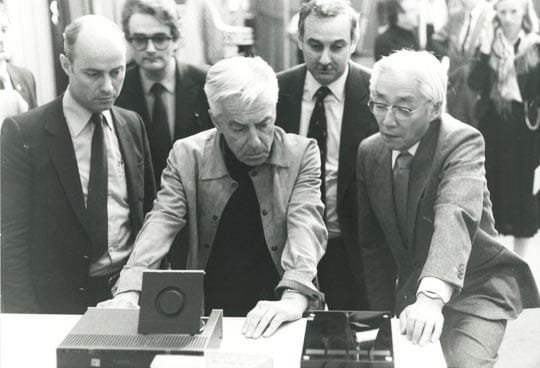Under the heading 'Die schwarzen Riesen schlagen zurück' (The black giants strike back), an extensive article appeared on 21 August 1981 in the German newspaper 'Die Zeit'. Because Philips and Sony had announced the Compact Disc, while the major US record labels CBS, Warner and RCA wanted no part of it. Everyone had to keep their hands off the good old LP.
Admittedly, the record companies were having difficult times, because their sales had been under pressure for two years in a row. And then the announcement of Compact Disc, which would mean the end of the LP record. Only the exact date of this 'revolution' was not yet known. But conductor Herbert von Karajan was a big advocate of the Compact Disc. At a press conference where he stated his support for the system, he compared music on traditional records to 'gas lighting'.

Conductor Herbert von Karajan with Akiyo Morita, President of Sony, at his left and Joop Sinjou of Philips at his right.
The record companies were convinced that they had found a great solution for extending the life of the gramophone record by many years, and they introduced it at the IFA exhibition in Berlin in 1981. The new formula was the CX (Compatible Expansion) system from CBS, a kind of electronic noise-suppression system that reduced the noise when a record was played and increased the dynamic range significantly, by about 20 dB. According to CBS all the typical interference was eliminated, resulting in a record that truly achieved the high sound quality of live music. Consumers didn’t even need a new record player, just a small decoder box costing around DEM 100 between the record player and the amplifier. With this enhancement the gramophone record would be almost up to the standard of a Compact Disc costing around DEM 40, with a record costing only half as much. Quite apart from the cost of Compact Disc player itself, which was expected to be more than DEM 1,000.
The introduction of CX meant the start of a battle. First of all the many millions that Sony and Philips had invested in the development of the laser disc system in the preceding years, and for which they expected a return of a few cents on each CD and a few per cent of the selling price of each player. But as far as the record companies were concerned, they thought the installed base of at least 300 million record players was a strong argument, all of them ready to play the billions of gramophone records. They also emphasized the compatibility - wherever a record was pressed, it could be played on any record player. At that time this was regarded as a guarantee for business success, and an effective weapon against any far reaching changes.
But even as acceptance of the CD grew, although no-one then could have guessed how rapidly that would happen, further counter-proposals were still emerging. One of them came from Telefunken, which had developed its own digital disc format called Mini Disc. But the disc had grooves and was ‘read’ mechanically, instead of by a laser. The big argument for the system was that no new factories were needed to produce the discs: they could be made on the existing presses using the same materials as LP records.
According to a contemporary review a Mini Disc played on the new Mini Disc player gave a reproduction quality comparable to that of a Compact Disc. The double-sided Mini Disc, with a playing time of two times sixty minutes, was even claimed to cost less to make than the LP, and only one-third as much as the new Philips/Sony CD. But this system ultimately fell victim to the reluctance of the record industry to accept any change at all. And Telefunken, believing its system had no future, became the first German licensee of the CBS CX decoder.
